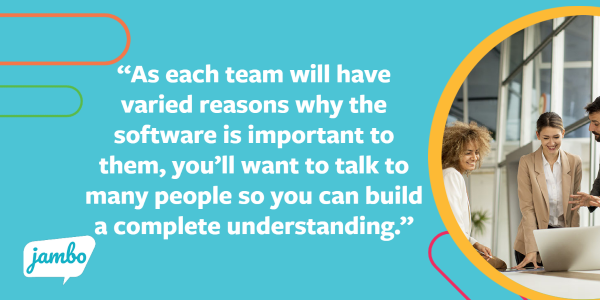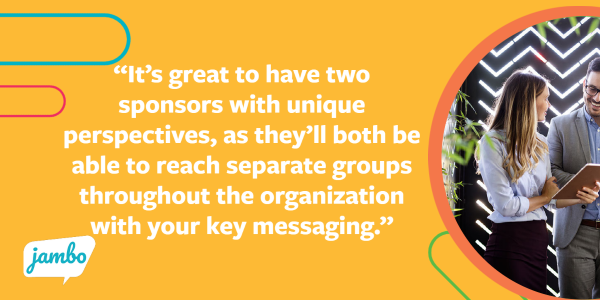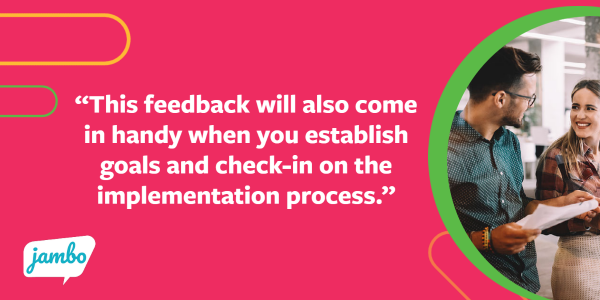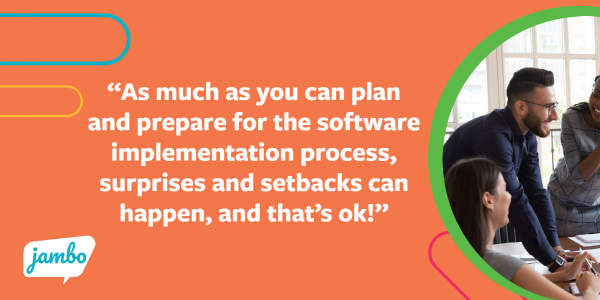
In this blog, the Jambo Customer Success team shares 14 tips for planning a successful Stakeholder Relationship Management (SRM) software implementation.
You’ve worked hard to choose a new SRM software and now it’s time to prepare your team for using it. Here at Jambo HQ, we know a thing or two about running a successful software implementation, so we’ve compiled a list of 14 tips that you can put into action right from the moment you purchase your new software to create an easy transition for your team.
14 tips for planning a successful SRM software implementation:
- Determine why you need software
- Communicate the why
- Explain what the change looks like
- Find your sponsors and champions
- Clarify what you need
- Identify the required resources
- Introduce your teams to new terminology
- Build internal excitement
- Understand the different comfort levels
- Identify your key timelines
- Establish regular check-ins
- Align your check-ins with your internal processes
- Keep communication open and flexible
- Work with your software vendor
1. Understand why you need software

You want to start with the end in mind and understand why your organization or department needs new software in the first place and what you’re hoping to achieve with it. Think about the risks of not using the software, the challenges you are trying to solve, and the opportunities this new software will create. For example, senior management may not need to use the software themselves, but they may need access to the reports the software can produce. In this case, you would ask them to define, “Why are these reports important?” As each team will have varied reasons why the software is important to them, you’ll want to talk to many people so you can build a complete understanding.
2. Communicate the why to your teams
Once you understand why you need the new software, you can build these answers into key messages to use when communicating with your team(s). This way, everyone will be on the same page about the need and the value. If possible, share a deadline of when you hope to complete the software implementation. This timeline can help your teams stay focused and motivated, especially if they feel bogged down with the changes coming.
3. Explain what the change will look like for teams
Beyond defining and sharing why you need the software; you’ll want to communicate what this change or transition will look like for your team(s). Try to keep things as simple as possible, especially in the beginning. Start by engaging the team(s) who will be users or who will be impacted by the new software and explain:
- What part of their current process will change?
- What’s expected from them through during the implementation? (Do they need to attend training, how often, etc.)
- When will the new software be available to them?
- What level of access will they have?
Remember, it’s not about understanding how to use the software right away (that will come later with training and support). What you want to focus on first is helping your teams understand why the software is important and how it affects them so they can buy-into the change.
4. Find and secure software sponsors

At Jambo, we call sponsors “Champions.” Sponsors or champions are the people who understand why the software is important, the risks involved by not using it, and the value it offers to people and their job roles. They’re invested in learning about the software and helping their teams utilize it to its full potential.
Ideally, you’d want to find around two sponsors in your organization: the first sponsor will ideally have high influence (and a lower level of involvement with the software). We suggest someone from senior management who can speak to organizational objectives and provide access to resources. The second sponsor will ideally have a prominent level of involvement with the software but a lower level of influence. We suggest someone who is accessible to users for questions and support. It’s great to have two sponsors with unique perspectives, as they’ll both be able to reach separate groups throughout the organization with your key messaging.
Pro-tip for finding sponsors: Think about the people who in some ways have experienced the pain points of not having software. They will be super users or involved with the people who will be the super users. They’re often the person who will be the point of contact between the software vendor and the organization and will have been involved in reviewing a demo and/or the procurement process.
5. Clarify what you'll need from people
Clarify people’s roles in the software implementation so they know what they need to do to help make this transition. Brainstorming all the tasks required and making it clear who’s responsible for what will help the implementation run more smoothly. Things to think about include:
- Does existing data need to be pulled from spreadsheets or another software to be added into the new software?
- Does the existing data need to be cleaned up first?
It’s also important to think of the things that you need from your software vendor. At Jambo, our Customer Success team will ask you what success looks like so they can understand how to help you get there. Things to think of include:
- What type of reports will you need to run and how often.
- What information do you need in these reports?
- Do you need any custom fields to ensure you can log and filter this data easily?
- Is there information you don’t have but would like to?
6. Identify the required resources
Along the way, you’ll notice the need for additional resources. Think of things like:
- Does anyone need two monitors?
- Does anyone need help downloading a specific browser?
- Does anyone need access to a shared drive?
You’ll want to stay on top of any required resources to make sure your team(s) have everything they need to succeed, so work with them, listen to their feedback and be ready to adjust your plans and add resources where and when needed.
7. Introduce your teams to new terminology early-on
Learning something new can be overwhelming, and even something as small as learning new terminology can be daunting. The more you can use new terminology associated with the software and familiarize your team(s) with it before everyone starts using the software, the more comfortable the transition will be for everyone.
For example, with Jambo, we use terminology like “communication records” and have an “issues” module and a “campaigns” module. In this case, you would explain what these words mean to potential users so they can get their head around them and start using them frequently. This early introduction of software terminology helps prepare people by giving them time to understand the terms and build connections with what they already know or use.
8. Build internal excitement through conversation

It’s always a great idea to build internal excitement about the new software. Talk to people to find out how they believe the new software will help make their jobs easier. If some people aren’t sure, share other people’s excitement with them. These conversations can help to create some important positivity before and during the transition period.
You’ll also learn more about other people’s perspectives and the benefits or opportunities they’re looking forward to, which may be things that you hadn’t considered yourself! Then, you can share these insights and build excitement across the organization. This feedback will also come in handy when you establish goals and check-in on the implementation process.
9. Understand The Different Comfort Levels With Technology And Provide Extra Support Where Needed
Everyone will have different comfort levels with technology, so it’s vital to check-in with each potential user of the software. Have they used cloud-based software? Are they familiar with the term Stakeholder Relationship Management (SRM) software? Do they know how to pin the login page for easy access? If not, you want to help them feel supported through this transition period, so they don’t get left behind.
Encourage Questions
To provide support, you’ll want to make it clear that there are no silly questions regarding the software implementation and that everyone is working towards the same goal. You’re all in this together! Keep communication channels open, and make sure everyone knows where they can go for help.
Add a Buddy System
Once you identify any members who are uncomfortable with new technology or are new to cloud-based software, you can consider creating a buddy system where they’re partnered with another team member who’s more experienced (this is also called peer support and it is change management best practice). Peer support is judgement-free and can help teams move towards successful adoption of a new software.
Work With Your Software Vendor
Don’t forget to rely on your SRM software vendor for help. At Jambo, our Customer Success team is ready and available to answer questions. We also have an online knowledge base with articles and on-demand videos and webinars that can be used to supplement training during the implementation process.
10. Identify Your Key Timelines
If you have any key timelines or important dates you or your organization is hoping to meet, you should identify those early on and communicate them so everyone can work together to meet them. For example, if you have activities planned that need to be logged or you need to be able or produce a report by a specific date, you need to communicate these deadlines and work backwards from them so that you can be up and running in time. Your software vendor will be able to provide timeline recommendations and offer insights into what’s possible within certain timeframes.
11. Establish Regular Team Check-Ins
Check-ins are a good opportunity to evaluate whether your goals are on track. They also offer an opportunity to see how things are going with your team(s). If, during a check-in, you realize you’re not on track to meet a goal, you can investigate what’s not working and decide what needs to change. Doing regular check-ins as a team helps create transparency and understanding.
12. Align Your Check-Ins With Your Internal Processes
You want to align team check-ins with your established internal processes. This will help create consistent opportunities for people to share updates and feedback. Consider adding a regular 10-minute check-in during an established planning session or as an agenda item during a weekly team meeting. By aligning check-ins with your internal processes, they become part of your routine.
13. Keep Communication Lines Open And Flexible

As much as you can plan and prepare for the software implementation process, surprises and setbacks can happen, and that’s ok! Regardless of whether things are going smoothly or not, make sure you’re communicating with your team(s) and listening to their feedback. This is a team process, and everyone’s perspectives will matter. As you continue to gather feedback and work together, try to be flexible with the plan and adjust when necessary.
This is not a “one size fits all” situation, so being flexible and using clear and honest communication will help keep everyone on the same page and feeling respected, which can make a significant difference in the success of your implementation.
14. Build a Good Relationship With Your Software Vendor
While it’s important to communicate with your teams, you’ll also want to communicate with your software vendor. As we mentioned above, they want you to be successful and can support you throughout the implementation process.
At Jambo, we meet with sponsors (or champions) and other key users to go through our implementation process and tailor it for you. Our expert Customer Success team consider your needs and offer you advice to help you launch a successful implementation. We help set you and your team(s) up for success with our regular support, check-ins, and education opportunities (like webinars, tip emails and resources). This personalized support is just one of the many benefits you get from choosing Jambo.
So there they are—14 tips for planning a successful SRM software implementation. We hope they help you get ready for a great implementation so you and your team(s) can hit the ground running. Best of luck with your new SRM software!
Learn More About Jambo
At Jambo, your success is our top priority, and we know it all starts with a great implementation. To help you and your team(s) prepare for using your new software, we offer an easy 5-step implementation process and ongoing support from our Customer Success team to help you reach your goals. If you’d like to learn more about the Jambo book a 15-minute discovery call with a Jambo expert.






